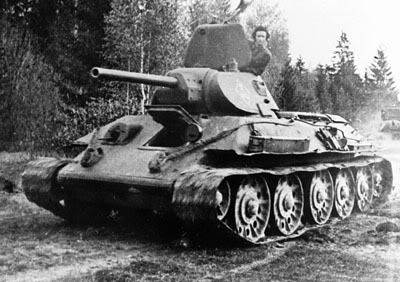SS Totenkopf Grenadiers at Kursk
Following the defeat at Stalingrad (1942-43), the Germans launched a massive offensive known as Operation Citadel, in the East on July 4,1943. The climax of Operation Citadel, the Battle of Kursk, involved as many as 6,000 tanks, 4,000 aircraft and 2 million fighting men and is remembered as the greatest tank battle in history.
Statistics
Total tanks : 3,253 German, 7,360 Russian
Soviet air sorties accounted for 5.7% of German tank losses.
Losses at Kursk: 55,000 German causalites, 177,000 Russian causalties
Tank Losses: 300 destroyed German tanks 1614 destroyed Russian tanks
Damaged tanks: 1,612 damaged German tanks, 2,700 damaged Russian tanks.
A lot of German tank damage was from minefields, and recovery of damaged (but not destroyed) vehicles and clearing minefields slowed the advance.
(These figures are from the new Kursk book by Glantz and House, stats are from recently released Soviet/German archives.; this book is considered to be one of the most accurate on Kursk.)
Kursk was a German tactical victory, but strategic failure.
General Erich von Manstein was convinced he could have triumphed had Hitler not interfered
Whether it would have changed the course of history is another question.
The high-water mark of the battle was the massive armor engagement at Prochorovka (also spelled Prokhorovka), which began on July 12. But while historians have categorized Prochorovka as a victory of improved Soviet tactics over German firepower and heavy tanks, new evidence casts the struggle at the 'gully of death' in a very different light.
The Germans' goal during Citadel was to pinch off a large salient in the Eastern Front that extended 70 miles toward the west. Field Marshal Von Kluge's Army Group Center would attack from the north flank of the bulge, with Colonel General Model's Ninth Army leading the effort, General Zorn's XLVI Panzer Corps on the right flank and Maj. Gen. Harpe's XLI Panzer Corps on the left.
General Lemelsen's XLVII Panzer Corps planned to drive toward Kursk and meet up with Field Marshal Erich von Manstein's Army Group South, Col. Gen. Hermann Hoth's Fourth Panzer Army and the Kempf Army, commanded by General Werner Kempf.
Opposing the German forces were the Soviet Central Front, led by General Konstantin Rokossovsky, and the Voronezh Front, led by General Nikolai Vatutin. The Central Front, with the right wing strengthened by Lt. Gen. Nikolai Pukhov's Thirteenth Army and Lt. Gen. Galinin's Seventeenth Army, was to defend the northern sector. To the south, the Voronezh Front faced the German Army Group South with three armies and two in reserve. The Sixth Guards Army, led by Lt. Gen. Mikhail Chistyakov, and the Seventh Guards Army, led by Lt. Gen. Shumilov, held the center and left wing. East of Kursk, Col. Gen. Ivan Konev's Steppe Military District (renamed Steppe Front on July 10, 1943) was to hold German breakthroughs, then mount the counteroffensive.
If their plan succeeded, the Germans would encircle and destroy more than five Soviet armies.
Attack from the North
Advancing over the steppe
Such a victory would have forced the Soviets to delay their operations and might have allowed the Wehrmacht desperately needed breathing room on the Eastern Front.
Model's Ninth Army never came close to breaking the Soviet defenses in the north, however, and soon became deadlocked in a war of attrition that it could not win.
Zis Anti-tank Guns being readied

Katyusha having her say.
On the southern flank, Kempf's III Panzer Corps, commanded by General Breith, also encountered tough Soviet resistance.

Action in the South
The Psel river was the last natural barrier between Manstein's panzers and Kursk.
The Fourth Panzer Army's attack on the town was led by SS General Hausser's II SS Panzer Corps, General Von Knobelsdorff's XLVIII Panzer Corps and General Ott's LII Army Corps.
Hausser's corps was made up of three panzer divisions–the 1st Leibstandarte Adolf Hitler (Adolf Hitler's bodyguard), 2nd SS Das Reich (The Empire) and 3rd SS Totenkopf (Death's Head). Although all three were technically Panzergrenadier divisions, each had more than 100 tanks when Citadel began.

German armour advancing
Contrary to popular belief, the Elefant/Ferdinand was a success in its role: as an over-watch panzer.
It remained at a long distance from the enemy.
Figures indicate that the elephant had 10 to 1 kill ratio against Soviet armor.
SS Totenkopf Grenadiers in Pea-dot Camo and Tiger I commander confer early in the battle
Work-horses of the Army PzKfw III or IV in July 1943
To Victory: T-34s lined up
Tiger I with Schurtzen at Kursk

Das Reich Insignia Grossdeutschland Div Insignia
Knobelsdorff's corps was composed of the 167th and 332nd infantry divisions, the 3rd and 11th panzer divisions, Panzergrenadier Division Grossdeutschland and Panther Brigade Decker, and Ott's corps contained the 25th and 57th infantry divisions.

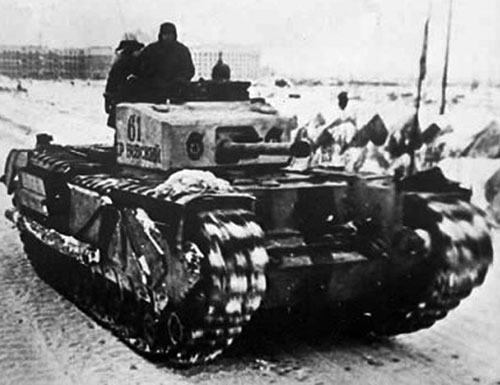

The Soviet operational armored reserve, General Mikhail Katukov's First Tank Army, was already in action against Hoth's Fourth Panzer Army south of the Psel.
Katukov's army had been unable to prevent the Germans from reaching the river, however. His VI Tank Corps, originally equipped with more than 200 tanks, had only 50 left by July 10 and 11, and the other two corps of Katukov's army also had sustained serious losses.
On July 10, the 3rd SS Division Totenkopf, commanded by SS Maj. Gen.Hermann Priess, had established a bridgehead over the Psel, west of Prochorovka. By July 11, the division's panzer group had crossed the river on pontoon bridges and reached the bridgehead. What was left of Katukov's armor regrouped to oppose the XLVIII Panzer Corps below Oboyan or counterattack the Psel bridgehead. Reinforced with the XXXIII Rifle Corps and X Tank Corps, Katukov launched continuous attacks on the Totenkopf units on the north bank of the river.
During the evening of July 11, Hausser readied his divisions for an assault on Prochorovka.
Totenkopf anchored the left flank of the corps, while Leibstandarte, commanded by SS Maj. Gen. Theodore Wisch, was in the center, assembled west of the town between a rail line and the Psel.
Das Reich, commanded by SS Lt. Gen. Walter Krüger, moved into its attack zone on the corps' right flank, which was several kilometers south of Tetrevino and southwest of Prochorovka.
While Hausser's SS divisions prepared for battle, there was feverish activity in the Soviet camp as well. On July 11, the Fifth Guards Tank Army arrived in the Prochorovka area, having begun its march on July 7 from assembly areas nearly 200 miles to the east. The army consisted of the XVIII and XXIX Tank Corps and the V Guards Mechanized Corps. Rotmistrov's 650 tanks were reinforced by the II Tank Corps and II Guards Tank Corps, increasing its strength to about 850 tanks, 500 of which were T-34s.
T-34-76 mm
Prochotovka
Prochorovka is one of the best-known of the many battles on the Eastern Front during World War II. It has been covered in articles, books and televised historical documentaries, but these accounts vary in accuracy; some are merely incomplete, while others border on fiction.


In the generally accepted version of the battle, the three SS divisions attacked Prochorovka shoulder to shoulder, jammed into the terrain between the Psel and the railroad. A total of 500 to 700 German tanks, including dozens of Panzerkampfwagen Mark V Panther medium tanks with 75 mm guns and Panzerkampfwagen Mark VI Tiger heavy tanks with deadly 88 mm cannons, lumbered forward.

Hundreds of nimble Soviet T-34 medium tanks raced into the midst of the SS armor and threw the Germans into confusion. The Soviets closed with the Panzers, negating the Tigers' 88mm guns, outmaneuvered the German armor and knocked out hundreds of German tanks.

The Soviet tank force's audacious tactics resulted in a disastrous defeat for the Germans, and the disorganized SS divisions withdrew, leaving 400 destroyed tanks behind, including between 70 and 100 Tigers and many Panthers.

Those losses smashed the SS divisions' fighting power, and as a result Hoth's Fourth Panzer Army had no chance to achieve even a partial victory in the south.

While it makes a dramatic story, nearly all of this battle scenario is essentially myth.
Careful study of the daily tank strength reports and combat records of II SS Panzer Corps (Available on microfilm at the National Archives in Washington, D.C) provides information that forces a historical reappraisal of the battle.
These records show, first of all, that Hausser's corps began with far fewer tanks than previously believed and, more important, that they suffered only moderate losses on July 12, 1943.
As those reports were intended to allow the corps commander to assess the combat strength of his divisions, they can be considered reasonably accurate. Considering that information, it seems that the Germans may have been near a limited success on the southern flank of the salient.
The number of SS tanks actually involved in the battle has been variously reported as high as 700 by some authorities, while others have estimated between 300 to 600. Even before the Battle of Kursk began, however, the II SS Panzer Corps never had 500 tanks, much less 700.

On July 4, the day before Operation Citadel was launched, Hausser's three divisions possessed a total of 327 tanks between them, plus a number of command tanks.

By July 11, the II SS Panzer Corps had a total of 211 operational tanks
Totenkopf had 94 tanks, Leibstandarte had only 56 and Das Reich possessed just 61.
Damaged tanks or tanks undergoing repairs are not listed.

2 Famo Heavy Half-tracks recovering a broken down but servicable Tiger I. Potze staff car in the foreground
Only 15 Tiger tanks were still in action at Prochorovka, and there were no SS Panthers available.
The battalions that were equipped with Panthers were still training in Germany in July 1943.
On July 13, the day after the Battle of Prochorovka, Fourth Panzer Army reports declared that the II SS Panzer Corps had 163 operational tanks, a net loss of only 48 tanks.
Actual losses were somewhat heavier, the discrepancy due to the gain of repaired tanks returned to action.
Closer study of the losses of each type of tank reveals that the corps lost about 70 tanks on July 12.
In contrast, Soviet tank losses, long assumed to be moderate, were actually catastrophic.

In 1984, a history of the Fifth Guards Tank Army written by Rotmistrov himself revealed that on July 13 the army lost 400 tanks to repairable damage. He gave no figure for tanks that were destroyed or not available for salvage. Evidence suggests that there were hundreds of additional Soviet tanks lost.
Several German accounts mention that Hausser had to use chalk to mark and count the huge jumble of 93 knocked-out Soviet tanks in the Leibstandarte sector alone.
Other Soviet sources say the tank strength of the army on July 13 was 150 to 200, a loss of about 650 tanks. Those losses brought a caustic rebuke from Josef Stalin. Subsequently, the depleted Fifth Guards Tank Army did not resume offensive action, and Rotmistrov ordered his remaining tanks to dig in among the infantry positions west of the town.

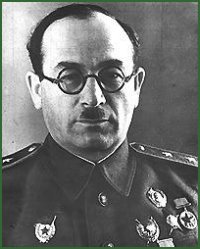
Rotmistrov later in the war
Another misconception about the battle is the image of all three SS divisions attacking shoulder to shoulder through the narrow lane between the Psel and the rail line west of Prochorovka.
Only Leibstandarte was aligned directly west of the town, and it was the only division to attack the town itself. The II SS Panzer Corps zone of battle, contrary to the impression given in many accounts, was approximately nine miles wide, with Totenkopf on the left flank, Leibstandarte in the center and Das Reich on the right flank.

Totenkopf's armor was committed primarily to the Psel bridgehead and in defensive action against Soviet attacks on the Psel bridges. In fact, only Leibstandarte actually advanced into the corridor west of Prochorovka, and then only after it had thrown back initial Soviet attacks.
Early on July 12, Leibstandarte units reported a great deal of loud motor noise, which indicated massing Soviet armor. Soon after 5 am., hundreds of Soviet tanks, carrying infantry, rolled out of Prochorovka and its environs in groups of 40 to 50.

KV-1s and Soviet Infantry Advance
Waves of T-34 and T-70 tanks advanced at high speed in a charge straight at the startled Germans. When machine-gun fire, armor-piercing shells and artillery fire struck the T-34s, the Soviet infantry jumped off and sought cover. Leaving their infantry behind, the T-34's rolled on. Those Soviet tanks that survived the initial clash with SS armor continued a linear advance and were destroyed by the Germans.

Dismounted Soviet Infantry surging forwards
When the initial Soviet attack paused, Leibstandarte pushed its armor toward the town and collided with elements of Rotmistrov's reserve armor. A Soviet attack by the 181st Tank Regiment was defeated by several SS Tigers, one of which, the 13th (heavy) Company of the 1st SS Panzer Regiment, was commanded by 2nd Lt. Michael Wittmann, the most successful tank commander of the war.

Michael Wittmann
Wittmann's group was advancing in flank support of the German main attack when it was engaged by the Soviet tank regiment at long range.
The Soviet charge, straight at the Tigers over open ground, was suicidal. The frontal armor of the Tiger was impervious to the 76 mm guns of the T-34s at any great distance. The field was soon littered with burning T-34s and T-70s.
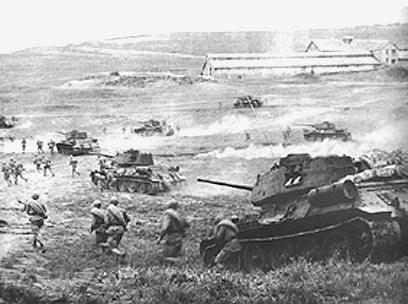
None of the Tigers were lost, but the 181st Tank Regiment was annihilated. Late in the day, Rotmistrov committed his last reserves, elements of the V Mechanized Corps, which finally halted Leibstandarte.

Das Reich began its attack from several kilometers southwest of Prochorovka and was quickly engaged by aggressive battle groups of the II Tank Corps and II Guards Tank Corps. Fierce, somewhat confused fighting broke out all along the German division's axis of advance. Battle groups of 20 to 40 Soviet tanks, supported by infantry and ground-attack planes, collided with Das Reich regimental spearheads. Rotmistrov continued to throw armor against the division, and combat raged throughout the day, with heavy losses of Soviet armor. Das Reich continued to push slowly eastward, advancing into the night while suffering relatively light tank losses.
Meanwhile, on the left flank, Soviet First Tank Army elements unsuccessfully tried to crush Totenkopf's bridgehead. The SS division fought off the XXXI and X Tank Corps, supported by elements of the XXXIII Rifle Corps. In spite of the Soviet attacks, Totenkopf's panzer group drove toward a road that ran from the village of Kartaschevka, southeast across the river and into Prochorovka.

Totenkopf Panzergrenadiers
The fighting, characterized by massive losses of Soviet armor, continued throughout July 12 without a decisive success by either side–contrary to the accounts given in many well-known studies of the Eastern Front, which state that the fighting ended on July 12 with a decisive German defeat.
These authors describe the battlefield as littered with hundreds of destroyed German tanks and report that the Soviets overran the SS tank repair units. In fact, the fighting continued around Prochorovka for several more days. Das Reich continued to push slowly eastward in the area south of the town until July 16.

Das Reich Sturm pioniere (Sappers) on board a Stug III
That advance enabled the III Panzer Corps to link up with the SS division on July 14 and encircle several Soviet rifle divisions south of Prochorovka. Totenkopf eventually reached the Kartaschevka-Prochorovka road, and the division took several tactically important hills on the north edge of its perimeter as well.
Those successes were not exploited, however, due to decisions made by Adolf Hitler.
Lost opportunity:
After receiving the news of the Allied invasion of Sicily, as well as reports of impending Soviet attacks on the Mius River and at Izyum, Hitler decided to cancel Operation Citadel.
Manstein argued that he should be allowed to finish off the two Soviet tank armies. He had unused reserves, consisting of three experienced panzer divisions of XXIV Panzer Corps, in position for quick commitment.
That corps could have been used to attack the Fifth Guards Tank Army in its flank, to break out from the Psel bridgehead or to cross the Psel east of Prochorovka.
All of the available Soviet armor in the south was committed and could not be withdrawn without causing a collapse of the Soviet defenses.
Manstein correctly realized that he had the opportunity to destroy the Soviet operational and strategic armor in the Prochorovka area.
Hitler could not be persuaded to continue the attack. Instead, he dispersed the divisions of the II SS Panzer Corps to deal with the anticipated Soviet diversionary attacks south of the Belgorod-Kharkov sector.
On the night of July 17-18, the corps withdrew from its positions around Prochorovka.
Thus, the battle for Prochorovka ended, not because of German tank losses (Hausser still had over 200 operational tanks on July 17) but because Hitler lacked the will to continue the offensive.
The SS panzer divisions were still full of fight; in fact, two of them continued to fight effectively in southern Russia for the rest of the summer.
Leibstandarte was ordered to Italy, but Das Reich and Totenkopf remained in the East.
Those two divisions and the 3rd Panzer Division, which replaced Leibstandarte, were transferred to the Sixth Army area, where they conducted a counterattack from July 31 to August 2 that eliminated a strong Soviet bridgehead at the Mius River.
Without pause, the three divisions were then transferred to the Bogodukhov sector in early August 1943. Under the command of the III Panzer Corps, they were joined by another unit, the Fifth SS Panzergrenadier Division Wiking.
During three weeks of constant combat, the four divisions played a major role in stopping the main Soviet post-Kursk counteroffensive, Operation Rumyantsev. They fought Rotmistrov's Fifth Guards Tank Army, rebuilt to 503 tanks strong, and major portions of the First Tank Army, now at 542 tanks.

6th Guards' Soviet Lend-lease M3 Lee/Grants
By the end of the month, Rotmistrov had less than 100 tanks still running. Katukov had only 120 tanks still in action by the last week of August. While at no time did any of the German divisions have more than 55 tanks in operation, they repeatedly blunted the thrusts of the two Soviet tank armies, which were also reinforced by several rifle corps.
Totenkopf repeatedly cut off and defeated all of the First Tank Army's thrusts toward the Kharkov-Poltava rail line. Das Reich threw back two Soviet tank corps south of Bogodukhov and blunted Rotmistrov's last major attack west of Kharkov, and the III Panzer Corps halted Operation Rumyantsev.
After Kharkov itself fell, however, the German front gradually collapsed.

The Soviets regrouped, committed additional strong reserves and renewed their attack toward the strategically important Dnepr River. Army Group South was subsequently forced to abandon much of southern Ukraine in a race for the safety of the Dnepr.
Despite the remarkable efforts of the German army and Waffen SS panzer divisions during July and August, the Germans were too weak to hold the Kharkov-Belgorod-Poltava sector after their summer losses.
It is apparent from their operations during the late summer that the SS panzer divisions were not destroyed at Prochorovka.
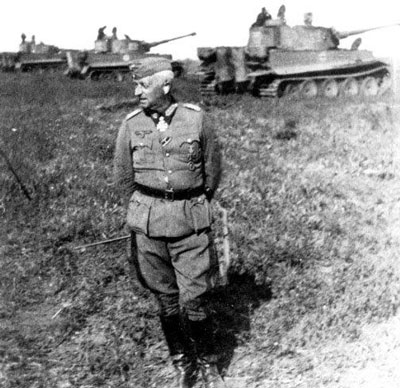
This reassessment of the battle provides food for thought regarding possible German successes if Manstein's Panzer reserves had been utilized as he had intended.
To what extent the course of events in Russia would have been changed is, of course, unknown, but it is interesting to speculate.
If Army Group South's Panzer reserve had been used to encircle and destroy the Fifth Guards Tank Army and the First Tank Army, the outcome of the war in Russia might have been significantly different.
Although it was beyond the German army's capabilities to force a military end to the war by the summer of 1943, a limited victory in the south could have resulted in a delay of Soviet strategic operations for months or perhaps longer. It is doubtful, however, that this pause would have lasted long enough for the Germans to transfer enough forces to the West to defeat the June 6, 1944, D-Day invasion.

But one fact is beyond any question, regardless of the number of tanks possessed by the Germans or Soviets or what might have been possible. Due to Hausser's Panzer corps' failure to take Prochorovka on July 12 and the subsequent misuse of German panzer reserves, the momentum of the Fourth Panzer Army was slowed dramatically.
When Hitler abandoned Operation Citadel on July 13, the Germans' last opportunity to influence events on a strategic level in the East was lost.

It is interesting that the information regarding German tank losses at Prochorovka has not been made available before now. Due to the lack of crucial primary-source information–especially the records of the II SS Panzer Corps on the Eastern Front–there had been no evidence to correct the erroneous accounts and impressions given in previous studies of the Eastern Front.
Waffen SS formations' records of their Eastern Front operations were not declassified until 1978-1981. By that time, many of the major works about the Eastern Front had already been published.
Later authors accepted the accounts of the battle as given in the earlier books and failed to conduct additional research.
As a result, one of the best known of all Eastern Front battles has never been understood properly.
Prochorovka was believed to have been a significant German defeat but was actually a stunning reversal for the Soviets because they suffered enormous tank losses.
As Manstein suggested, Prochorovka may truly have been a lost German victory, thanks to decisions made by Hitler.

It was fortunate for the Allied cause that the German dictator, a foremost proponent of the value of will, lost his own will to fight in southern Ukraine in July 1943. Had he allowed Mannstein to continue the attack on the two Soviet tank armies in the Prochorovka area, Manstein might have achieved a victory even more damaging to the Soviets than the counterattack that had recaptured Kharkov in March 1943.





















